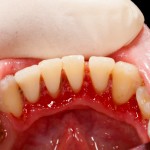
Periodontal disease are very common worldwide and while treating and controlling them is achievable reliable and consistent methods of replacing lost periodontal tissues continues to present a challenge.
The aim of this review was to assess the longitudinal efficacy of periodontal regenerative therapies to evaluate whether the benefits achieved by those regenerative therapies can be maintained and whether there is any difference in the maintenance of treatment outcomes among single and combination regenerative therapies.
Methods
Searches were conducted in the Medline, Embase and Cochrane CENTRAL databases. Randomised trials comparing at least 2 of 5 periodontal interventions {flap operation (FO); periodontal regenerative surgery with enamel matrix derivatives (EMD) ; periodontal regenerative surgery with guided tissue regeneration (GTR); periodontal regenerative surgery in conjunction with EMD and bone graft (EMD + BG) and periodontal regenerative surgery in conjunction with GTR and bone graft (GTR + BG)} measuring the outcomes probing pocket depth (PPD) reduction and clinical attachment level (CAL) gain with a minimum of 6 months follow up were considered.
Risk of bias was assessed by two reviewers independently using the Cochrane tool. longitudinal meta-analysis was undertaken using weighted least squares (WLS) mode
Results
- 52 studies were included.
- Most of the studies were considered to be at low risk of bias.
- Follow-up period ranged from 6 months to 10 years.
- The trends in the treatment outcomes were similar under different correlation structures.
- EMD and GTR achieved greater PPD reduction and CAL gain than FO in the long-term follow up, but no differences were found between EMD and GTR.
Conclusions
The authors concluded: –
the relative benefits of periodontal regeneration therapies compared to FO seemed to be maintained up to 5–10 years in terms of PPD reduction and CAL gain, although the confidence interval of the differences in treatment effects became much wider, when the time since the surgeries increased. Authors should be encouraged to report longitudinal results to provide more evidence on the long-term benefits of periodontal regeneration therapies.
Comments
This review has included a large number of studies most of which the authors consider to be at low risk of bias. However, looking at the table showing the risk of bias (RoB) scores in the supplementary data on-line only one study was considered to be at low risk for all 7 elements of the RoB scores, 14 were at high risk of bias with the 37 remaining studies all have one element at unclear risk.
While a good deal of deal about the included studies is provided in the on-line supplementary data no information is provided about the sample sizes of the included studies. Longitudinal analysis was conducted for 4 comparisons EMD versus FO; GTR versus FO; EMD versus GTR and (4) GTR + BG versus FO. And while some statistically significant differences were identified the size of these difference raise issues as to whether there are clinically important. It is also important to note that while the conclusions refers to 5- 10 year outcomes only a small number of treatment comparisons provided data at these time intervals as the vast majority were at less than 6 months or at twelve months. Consequently, the findings of this review should be viewed cautiously.
Links
Primary paper
Wu YC, Lin LK, Song CJ, Su YX, Tu YK. Comparisons of periodontal regenerative therapies: A meta-analysis on the long-term efficacy. J Clin Periodontol. 2017May;44(5):511-519. doi: 10.1111/jcpe.12715. Epub 2017 Apr 18. Review. PubMed PMID: 28278363.
Other references
Dental Elf -6th Feb 2017
